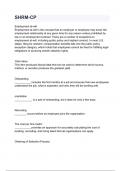SHRM-CP
Employment
at-will
Employment
at-will
is
the
concept
that
an
employer
or
employee
may
sever
the
employment
relationship
at
any
given
time
for
any
reason
unless
prohibited
by
law
or
an
employment
contract.
There
are
a
number
of
exceptions
to
employment
at-will,
including
public
policy
and
implied
contract.
In
most
U.S.
states,
filing
for
workers'
compensation
benefits
falls
into
the
public
policy
exception
category,
which
holds
that
employees
cannot
be
fired
for
fulfilling
legal
obligations
or
pursuing
certain
statutory
rights.
Yield
ratios
This
item
produces
factual
data
that
can
be
used
to
determine
which
source,
method,
or
recruiter
produces
the
greatest
yield.
Onboarding
___________
includes
the
first
months
at
a
job
and
ensures
that
new
employees
understand
the
job,
what
is
expected,
and
who
they
will
be
working
with.
orientation
____________
is
a
part
of
onboarding,
but
it
lasts
for
only
a
few
days.
Recruiting
________
occurs
before
an
employee
joins
the
organization.
The
cost
per
hire
metric
___________
provides
an
approach
for
accurately
calculating
the
cost
of
locating,
recruiting,
and
hiring
talent
that
all
organizations
can
apply.
Ordering
of
Selection
Process Organize/summarize
information
in
terms
of
selection
criteria.
Identify
and
rank
acceptable
candidates.
Collect
additional
information
as
necessary.
Make
an
offer
to
the
top
candidate.
Structured
interview
In
the
structured
interview,
the
interviewer
asks
every
applicant
the
same
questions.
A
job
analysis
________
looks
at
the
knowledge,
skills,
and
abilities
required
for
a
person
to
have
a
reasonable
chance
of
successfully
performing
the
job.
All
jobs
must
be
interrelated
to
accomplish
the
organization's
mission
and
goals;
____________
is
the
first
step
in
this
process.
A
___________
is
conducted
for
the
job,
not
the
person
doing
the
job.
An
essential
job
function
____________
is
one
that
is
performed
regularly
and
requires
highly
specialized
skills
or
expertise,
and,
in
many
cases,
the
reason
the
job
exists
is
to
perform
the
function.
Nonessential
functions
______________
typically
can
be
performed
by
many
different
people,
and,
if
not
completed,
there
are
often
minimal
consequences.
Greenfield
operation
A
new
facility
may
be
constructed
on
what
was
once
a
"green
field."
A
new
global
location
built
from
the
ground
up
is
often
referred
to
as
a
greenfield
operation.
Behavioral
interviews ____________
explore
real
experiences
and
how
the
applicant
responded
to
the
experiences
to
predict
future
performance.
Recruitment
cost
Direct
costs
of
turnover
can
be
quantified.
They
include
recruitment
fees
as
well
as
costs
for
sourcing,
hiring,
and
onboarding.
A
contingent
job
offer
___________________
is
contingent
on
the
candidate
passing
certain
tests
or
meeting
certain
requirements,
such
as
a
medical
examination,
physical
fitness
test,
and/or
a
psychological
test.
The
job
description
__________________
is
a
written
record
of
job
duties
and
responsibilities
and
will
be
most
valuable
in
grouping
jobs
with
similar
duties.
pre-employment
assessment
By
conducting
a
_____________________,
the
employer
gains
valuable
job-related
information
to
ensure
that
the
candidate
is
the
right
fit
for
the
role
and
the
organization.
The
assessment
should
not
eliminate
an
in-person
interview
and
will
not
increase
the
time
used
to
select
the
top
candidate.
The
assessment
can
assist
a
candidate
in
career
development
after
(but
not
before)
the
individual
is
hired.
employee
value
proposition
The
_____________
must
be
aligned
with
the
organizational
strategic
plan,
vision,
mission,
and
values
while
also
creating
an
image
that
attracts
people
and
provides
an
accurate
picture
of
employment.
An
employer
marketing
strategy
is
focused
on
advertising,
marketing,
and
branding;
therefore,
it
is
not
specifically
focused
on
the
company's
culture,
vision,
and
mission. Successful
differentiation
strategy
Differentiation
strategies
focus
on
setting
a
product
or
service
apart
from
its
competition
by
giving
it
unique
characteristics
that
consumers
value.
Differentiation
comes
from
a
variety
of
factors,
including
product/service
features,
marketing
approach,
and
delivery
system.
SWOT
analysis
Strengths,
weaknesses,
opportunities,
threats.
Strengths
and
weaknesses
refer
to
the
internal
environment.
Competitive
compensation
and
benefits
could
be
strengths,
and
lack
of
diversity
in
managerial
positions
could
be
weaknesses.
Opportunities
and
threats
are
external
factors.
environmental
scanning
collection
and
interpretation
of
information
about
forces,
events,
and
relationships
in
the
external
environment
that
may
affect
the
future
of
the
organization
or
the
implementation
of
the
marketing
plan
Six
Sigma
Approach
The
goal
of
Six
Sigma
is
to
achieve
a
level
of
quality
that
is
nearly
perfect,
with
only
3.4
defects
per
million
opportunities.
This
is
achieved
by
using
a
structured
approach
called
DMAIC
(Define,
Measure,
Analyze,
Improve,
Control)
to
identify
and
eliminate
causes
of
variation
and
improve
processes.
The
Six
Sigma
approach
to
project
management
is
focused
on
measuring
the
return
of
value
that
allows
empirical
analysis
to
inform
decision
making.
PESTLE
analysis
Analysis
of
the
external
political,
economic,
social,
technological,
legal
and
environmental
factors
affecting
a
business.
Organizations
that
use
PESTLE
analysis
data
are
much
more
likely
to
be
successful
because
the
information
facilitates
adapting
to
environmental
realities
that
may
impact
employee
engagement.




